Unit5Goingshopping老师教案新部编本
7A Unit 5 Going shopping教案-教案8
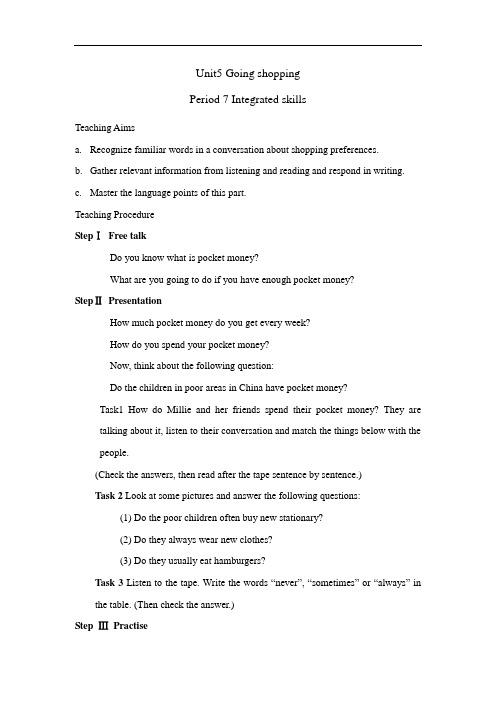
Unit5 Going shoppingPeriod 7 Integrated skillsTeaching Aimsa.Recognize familiar words in a conversation about shopping preferences.b.Gather relevant information from listening and reading and respond in writing.c.Master the language points of this part.Teaching ProcedureStepⅠFree talkDo you know what is pocket money?What are you going to do if you have enough pocket money?StepⅡPresentationHow much pocket money do you get every week?How do you spend your pocket money?Now, think about the following question:Do the children in poor areas in China have pocket money?Task1 How do Millie and her friends spend their pocket money? They are talking about it, listen to their conversation and match the things below with the people.(Check the answers, then read after the tape sentence by sentence.)Task 2 Look at some pictures and answer the following questions:(1) Do the poor children often buy new stationary?(2) Do they always wear new clothes?(3) Do they usually eat hamburgers?Task 3 Listen to the tape. Write the words “never”, “sometimes” or “always” in the table. (Then check the answer.)Step ⅢPractiseHow to help the poor children in poor areas?1.Save our pocket money.2.Raise some money for the poor children.3.Collect new pencils, pens, notebooks, writing paper, rulers and rubbersfor them.Millie and Simon saw this ad. in the newspaper. They want to help the children from poor areas in China. Read the ad. Then answer the questions.After reading the ad., please help them complete their letter to the Principal on Page 85.Step ⅣProductionYou also want to help the poor. Please write a letter to our principal. Tell him what you want to do for the poor.Step ⅤHomework【课堂检测】根据P84的图,填入所缺单词。
Unit 5 Going shopping教学案
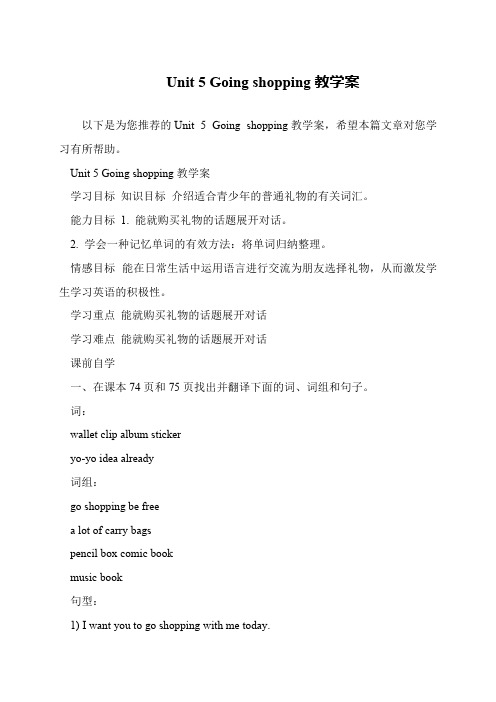
Unit 5 Going shopping教学案
以下是为您推荐的Unit 5 Going shopping教学案,希望本篇文章对您学习有所帮助。
Unit 5 Going shopping教学案
学习目标知识目标介绍适合青少年的普通礼物的有关词汇。
能力目标1. 能就购买礼物的话题展开对话。
2. 学会一种记忆单词的有效方法:将单词归纳整理。
情感目标能在日常生活中运用语言进行交流为朋友选择礼物,从而激发学生学习英语的积极性。
学习重点能就购买礼物的话题展开对话
学习难点能就购买礼物的话题展开对话
课前自学
一、在课本74页和75页找出并翻译下面的词、词组和句子。
词:
wallet clip album sticker
yo-yo idea already
词组:
go shopping be free
a lot of carry bags
pencil box comic book
music book
句型:
1) I want you to go shopping with me today.。
Going_shopping_教案_牛津英语7A_uint5
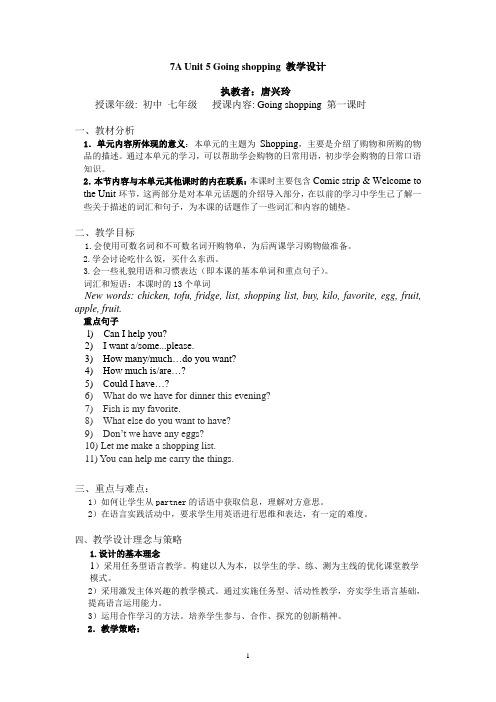
7A Unit 5 Going shopping教学设计执教者:唐兴玲授课年级: 初中七年级授课内容: Going shopping 第一课时一、教材分析1.单元内容所体现的意义:本单元的主题为Shopping,主要是介绍了购物和所购的物品的描述。
通过本单元的学习,可以帮助学会购物的日常用语,初步学会购物的日常口语知识。
2.本节内容与本单元其他课时的内在联系:本课时主要包含Comic strip & Welcome to the Unit环节,这两部分是对本单元话题的介绍导入部分,在以前的学习中学生已了解一些关于描述的词汇和句子,为本课的话题作了一些词汇和内容的铺垫。
二、教学目标1.会使用可数名词和不可数名词开购物单,为后两课学习购物做准备。
2.学会讨论吃什么饭,买什么东西。
3.会一些礼貌用语和习惯表达(即本课的基本单词和重点句子)。
词汇和短语:本课时的13个单词New words: chicken, tofu, fridge, list, shopping list, buy, kilo, favorite, egg, fruit, apple, fruit.重点句子l) Can I help you?2) I want a/some...please.3) How many/much…do you want?4) How much is/are…?5) Could I have…?6) What do we have for dinner this evening?7) Fish is my favorite.8) What else do you want to have?9) Don’t we have any eggs?10) Let me make a shopping list.11) You can help me carry the things.三、重点与难点:1)如何让学生从partner的话语中获取信息,理解对方意思。
英语:unit 5《going shopping》教案(1)(译林牛津七年级上).doc
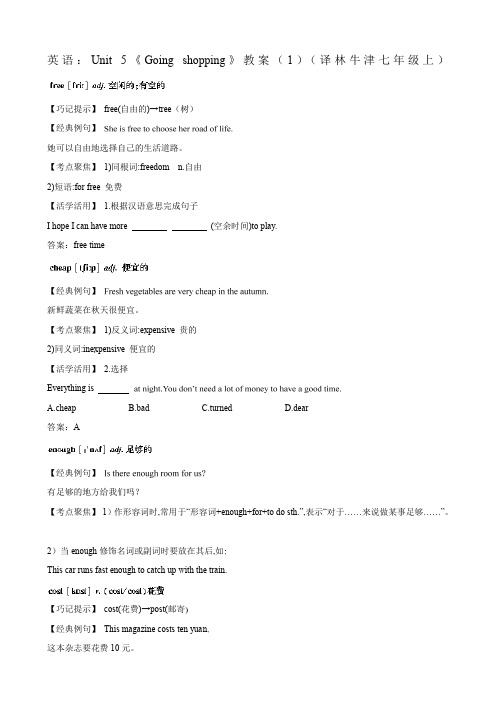
英语:Unit 5《Going shopping》教案(1)(译林牛津七年级上)【巧记提示】free(自由的)→tree(树)【经典例句】她可以自由地选择自己的生活道路。
【考点聚焦】1)同根词:freedom n.自由2)短语:for free 免费【活学活用】 1.根据汉语意思完成句子I hope I can have more (空余时间)to play.答案:free time【经典例句】新鲜蔬菜在秋天很便宜。
【考点聚焦】1)反义词:expensive 贵的2)同义词:inexpensive 便宜的【活学活用】 2.选择Everything isA.cheapB.badC.turnedD.dear答案:A【经典例句】有足够的地方给我们吗?【考点聚焦】1)作形容词时,常用于“形容词+enough+for+to do sth.”,表示“对于……来说做某事足够……”。
2)当enough修饰名词或副词时要放在其后,如This car runs fast enough to catch up with the train.【巧记提示】cost(花费)→post(邮寄【经典例句】This magazine costs ten yuan这本杂志要花费10元。
【考点聚焦】1)辨析cost,spend,pay 与①主语(物)+cost sb.+钱;②主语(人)+spend+时间/钱+on sth./in doing sth.;③主语(人)+pay+钱+for+sth.;④It takes+sb.+时间2)注意其过去式和过去分词都是cost。
【活学活用】 3.选择The book me ten yuanA.takesB.costedC.costD.paid答案:C【巧记提示】count(数【经典例句】法国和意大利是欧洲国家。
【考点聚焦】1)辨析country,nation,state和land:country和nation都有“国家”的意思。
UNIT 5 GOING SHOPPING教学案
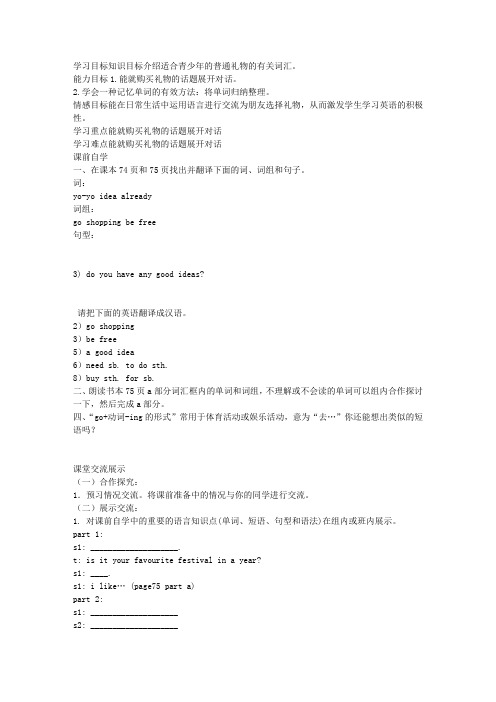
学习目标知识目标介绍适合青少年的普通礼物的有关词汇。
能力目标1.能就购买礼物的话题展开对话。
2.学会一种记忆单词的有效方法:将单词归纳整理。
情感目标能在日常生活中运用语言进行交流为朋友选择礼物,从而激发学生学习英语的积极性。
学习重点能就购买礼物的话题展开对话学习难点能就购买礼物的话题展开对话课前自学一、在课本74页和75页找出并翻译下面的词、词组和句子。
词:yo-yo idea already词组:go shopping be free句型:3) do you have any good ideas?请把下面的英语翻译成汉语。
2)go shopping3)be free5)a good idea6)need sb. to do sth.8)buy sth. for sb.二、朗读书本75页a部分词汇框内的单词和词组,不理解或不会读的单词可以组内合作探讨一下,然后完成a部分。
四、“go+动词-ing的形式”常用于体育活动或娱乐活动,意为“去…”你还能想出类似的短语吗?课堂交流展示(一)合作探究:1.预习情况交流。
将课前准备中的情况与你的同学进行交流。
(二)展示交流:1. 对课前自学中的重要的语言知识点(单词、短语、句型和语法)在组内或班内展示。
part 1:s1: ____________________.t: is it your favourite festival in a year?s1: ____.s1: i like… (page75 part a)part 2:s1: ____________________s2: ____________________part 3:remember(记住) the names of the birthday presents on page 75 part a. s1: …s2: …1) 听录音,回答下列问题。
2) 跟录音机朗读课文并操练对话。
3)结合实际,仿照书本p74页对话,各组自编一个对话并展示。
7A Unit 5 Going shopping教案

7A Unit 5 Going shopping教案7A Unit 5 Going shopping教案牛津7A Unit 5教案(1 课时)Teaching Contents:Comic strip& Welcome to the unit .Teaching goals:1. Knowledge goals(知识目标):1) Learning the vocabulary about presents.2) Making a dialogue about shopping2. Ability goals(能力目标):To help the students build the ability of self-study and self-assessment.Listening, speaking, reading and writing3. Emotion goals(情感目标):To help the students build a good relationship in daily life.Teaching important points:Learning some useful phrases:come up comic books hair clips music box pencil box photo album go shopping need sb.to do sth.Teaching difficult points:Talk about something about shoppingClass type: New LessonPeriod:1Teaching Methods:1) Discussion2) Individual or group work3) Task Teaching MethodTeaching aids: a computerTeaching Procedures:Step 1 Presentation (4’)1) Greetings.2) T: What ‘s your hobby?S:….T: I like shopping. I often buy many things for my son.look at these.(Showing the slide,present the new words,read and repeat)Step 2 Practice (3’)1)Read and remember the new words.2)Match the following according the explaination.Step 3 Presentation (3’)T:Simon’s birthday is coming, Daniel wants to buy him a birthday present,read part B and try to find out what he wants to buy.Step4 Check the answer(2’)Step5 Explaination (2’)Explain the language points:1、Simon’s birthday is coming up.Be coming(up): 快要来临,即将来2、have good ideas 有好主意3、What do you think? 你认为如何?4、What do you think of sb/sth?你认为某人或某物如何?Step6 Work in pairs (5’)Read the dialogue between the shopkeeper and buyer,prepair for several minutes and try to act it out.Step 7 Presentation(2’)T: (Showing the slide) Do you know Eddie? Tell me something about him.He is Hobo’s master,he wants to go shopping, Does Eddie want to go with him?Why does Hobo ask Eddie to go with him?Step 8 Listen, answer and check. (1’)Step9 Explaination(2’)1、I want you to go shoppingwant sb to do sth2、Here’s my wallet3、be free=have time4、I need you to carry all the bagsNeed sb to do sthStep10 Exercises(3’)根据课文内容,改写文章:Hobo is _______(空闲)on Sunday. He wants ____(go) ______(shop) in a new shopping mall(大卖场). He wants to buy ______(许多)things but he can’t ____(拎) all the bags. He is asking his _____(主人), Eddie, for help. “ Eddie, please _____(come) with me. I need you ___(help) me.” But Eddie ______(not want) to go.Step11 Read and act it out (6’)Step12 Consolidation exercise (6’)一、用所给词的适当形式填空。
7A Unit 5 Going shopping教案-Reading
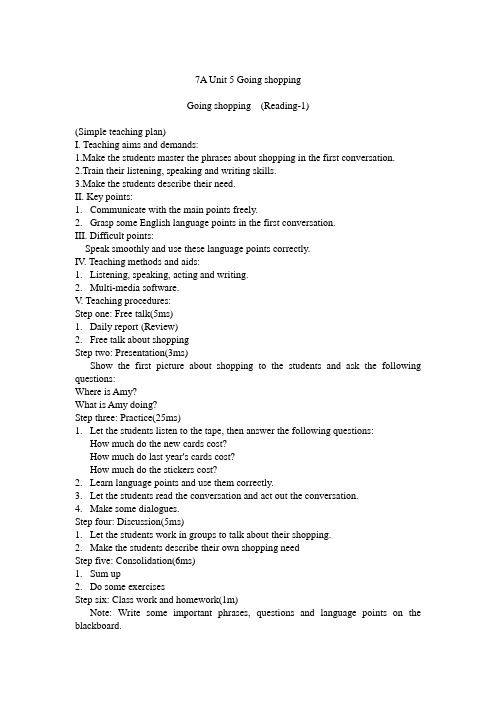
7A Unit 5 Going shoppingGoing shopping (Reading-1)(Simple teaching plan)I. Teaching aims and demands:1.Make the students master the phrases about shopping in the first conversation.2.Train their listening, speaking and writing skills.3.Make the students describe their need.II. Key points:municate with the main points freely.2.Grasp some English language points in the first conversation.III. Difficult points:Speak smoothly and use these language points correctly.IV. Teaching methods and aids:1.Listening, speaking, acting and writing.2.Multi-media software.V. Teaching procedures:Step one: Free talk(5ms)1.Daily report (Review)2.Free talk about shoppingStep two: Presentation(3ms)Show the first picture about shopping to the students and ask the following questions:Where is Amy?What is Amy doing?Step three: Practice(25ms)1.Let the students listen to the tape, then answer the following questions:How much do the new cards cost?How much do last year's cards cost?How much do the stickers cost?2.Learn language points and use them correctly.3.Let the students read the conversation and act out the conversation.4.Make some dialogues.Step four: Discussion(5ms)1.Let the students work in groups to talk about their shopping.2.Make the students describe their own shopping needStep five: Consolidation(6ms)1.Sum up2.Do some exercisesStep six: Class work and homework(1m)Note: Write some important phrases, questions and language points on the blackboard.7A Unit5 Going shoppingGoing shopping (Reading-2)(Simple teaching plan)I. Teaching aims and demands:1.Make the students master the phrases in the second conversation.2.Train their listening, speaking and writing skills.3.Let the students make some dialogues.II. Key points:municate with the main points freely.2.Grasp some English language points in the second conversation.III. Difficult points:Speak smoothly and use these language points correctly.IV. Teaching methods and aids:1.Listening, speaking, acting and writing2.Multi-media softwareV. Teaching procedures:Step one: Review(5ms)1.Let the students act out the first conversation.2.Make some dialogues with the first conversation as a model.Step two: Presentation(3ms)Show the second picture about shopping to the students and ask the following questions:What's Amy doing?Does she buy hair clips for Simon or Sandy?Step three: Practice(22ms)1.Let the students listen to the tape, then answer the following questions:How much money does Amy have?How much are the hair clips?Can she buy a CD for Sandy?2.Learn language points and use them correctly.3.Let the students read the conversation and act out the conversation.Step four: Discussion(7ms)1.Let the students make some dialogues about shopping.2.Let the students speak their dialogues loudly .Step five: Consolidation(6ms)1.Sum up2.Do some exercisesStep six: Class work: Make a dialogue about shoppingHomework: Copy new words and phrasesComplete workbooks(3ms)Note: Write some important phrases, questions and language points on theblackboard.After teaching thinking: The two conversations are very interesting and pragmatic. The students are interested in them.。
Unit 5 Going shopping教案
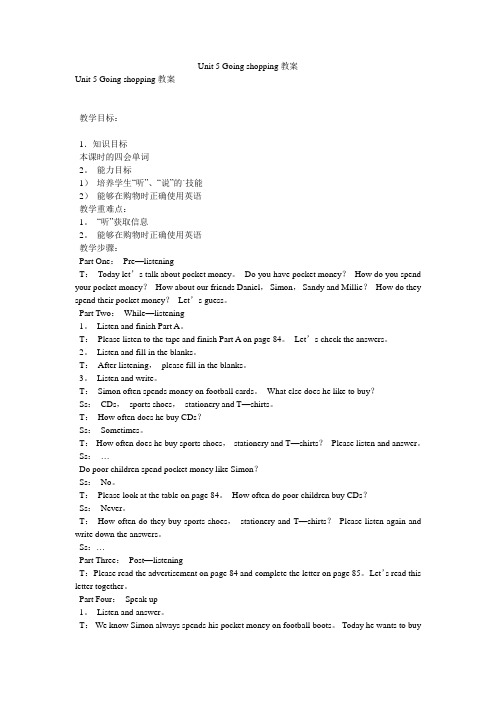
Unit 5 Going shopping教案Unit 5 Going shopping教案教学目标:1.知识目标本课时的四会单词2。
能力目标1)培养学生“听”、“说”的`技能2)能够在购物时正确使用英语教学重难点:1。
“听”获取信息2。
能够在购物时正确使用英语教学步骤:Part One:Pre—listeningT:Today let’s talk about pocket money。
Do you have pocket money?How do you spend your pocket money?How about our friends Daniel,Simon,Sandy and Millie?How do they spend their pocket money?Let’s guess。
Part Two:While—listening1。
Listen and finish Part A。
T:Please listen to the tape and finish Part A on page 84。
Let’s check the answers。
2。
Listen and fill in the blanks。
T:After listening,please fill in the blanks。
3。
Listen and write。
T:Simon often spends money on football cards。
What else does he like to buy?Ss:CDs,sports shoes,stationery and T—shirts。
T:How often does he buy CDs?Ss:Sometimes。
T:How often does he buy sports shoes,stationery and T—shirts?Please listen and answer。
Unit 5 Going shopping教案
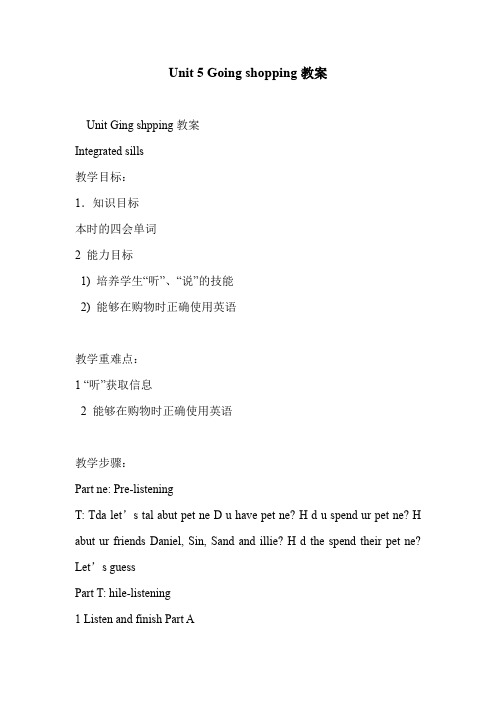
Unit 5 Going shopping教案Unit Ging shpping教案Integrated sills教学目标:1.知识目标本时的四会单词2 能力目标1) 培养学生“听”、“说”的技能2) 能够在购物时正确使用英语教学重难点:1 “听”获取信息2 能够在购物时正确使用英语教学步骤:Part ne: Pre-listeningT: Tda let’s tal abut pet ne D u have pet ne? H d u spend ur pet ne? H abut ur friends Daniel, Sin, Sand and illie? H d the spend their pet ne? Let’s guessPart T: hile-listening1 Listen and finish Part AT: Please listen t the tape and finish Part A n page 84 Let’s he the ansers 2 Listen and fill in the blansT: After listening, please fill in the blans3 Listen and riteT: Sin ften spends ne n ftball ards hat else des he lie t bu?Ss: Ds, sprts shes, statiner and T-shirtsT: H ften des he bu Ds?Ss: SetiesT: H ften des he bu sprts shes, statiner and T-shirts? Please listen and anserSs: …D pr hildren spend pet ne lie Sin?Ss: NT: Please l at the table n page 84 H ften d pr hildren bu Ds?Ss: NeverT: H ften d the bu sprts shes, statiner and T-shirts? Please listen again and rite dn the ansersSs:…Part Three: Pst-listeningT: Please read the advertiseent n page 84 and plete the letter n page 8 Let’s read this letter tgetherPart Fur: Spea up1 Listen and anserT: e n Sin alas spends his pet ne n ftball bts Tda he ants t bu a ne pair H uh are the ftball bts? Please listen and thin abut this questinSs: …2 Read and anserT: Please read after the tape and thin abut these questinsSs: …1Read it in grups2D an ativitT: Suppse u’d lie t bu ther things Please r in grups f three and tal abut the things in Part 2 n page 8 Use the dialgue in Part 1 as a del家庭作业:1 Read the dialgue n page 82 plete the flling dialgue arding t the hinese sentenes王兰打算买一条尺寸为24号的牛仔裤,可试穿后发现有点小。
新牛津译林版英语七年级上册《unit 5 going shopping》优秀教案4篇(重点资料).doc
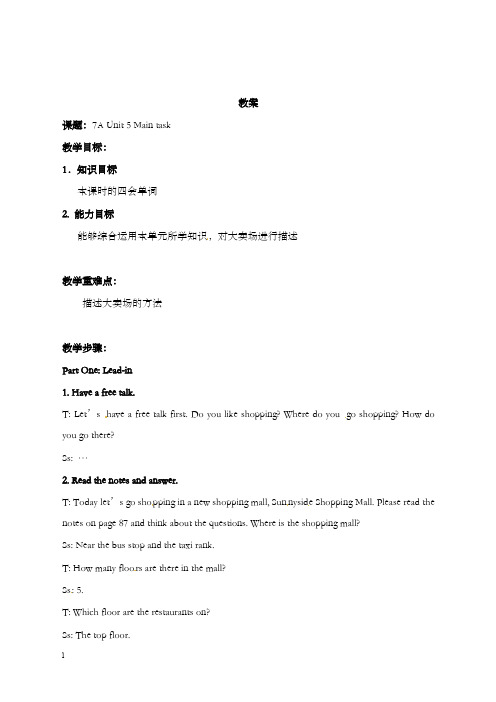
教案课题:7A Unit 5 Main task教学目标:1.知识目标本课时的四会单词2. 能力目标能够综合运用本单元所学知识,对大卖场进行描述教学重难点:描述大卖场的方法教学步骤:Part One: Lead-in1. Have a free talk.T: Let’s have a free talk first. Do you like shopping? Where do you go shopping? How do you go there?Ss: …2. Read the notes and answer.T: Today let’s go shopping in a new shopping mall, Sun nyside Shopping Mall. Please read the notes on page 87 and think about the questions. Where is the shopping mall?Ss: Near the bus stop and the taxi rank.T: How many floors are there in the mall?Ss: 5.T: Which floor are the restaurants on?Ss: The top floor.T: Is there a big cinema in the mall?Ss: Yes.T: Are there many people in the computer games centre?Ss: Yes.3. Fill in the blanks.T: Please fill in the blanks on page 87.Please read the article together.Part Two: Writing structureT: How many parts are there in this article?S s: Three.T: What are the three parts?Ss: …T: Part One is Paragraph One, introduction.Part Two is from Paragraph Two to Paragraph Five, main body.Part Three is Paragraph Six, conclusion.What are the thr ee parts abou t?Ss: …T: Part One is about where the shopping mall is.Part Two introduces what’s on each floor.Part Three tells us it’s a good place to go.Part Three: Outline1. Group work.T: Today we’re going to write about another shopping mall, Star Shopping Mall. What can you see in Star Shopping Mall? Please work in groups of four to talk about Star Shopping Mall according to the picture. Each student describes one floor and introduces it to the others.2. Complete the notes.T: Please complete the notes about Star Shopping Mall.Ss: …T: After finishing the notes, can you write an outline for the writing?Ss: …Part Four: PracticeAsk Ss to write about Star Shopping Mall.家庭作业:1. Read the article on page 87.2. Write an article about Star Shopping Mall.教案课题:7A Unit 5 Integrated skills教学目标:1.知识目标本课时的四会单词2. 能力目标1) 培养学生“听”、“说”的技能2) 能够在购物时正确使用英语教学重难点:1. “听”获取信息2. 能够在购物时正确使用英语教学步骤:Part One: Pre-listeningT: Today let’s talk about pocket money. Do you have pocket money? How do you spend yourpocket money? How about our friends Daniel, Simon, Sandy and Millie? How do they spend their pocket money? Let’s guess.Part Two: While-listening1. Listen and finish Part A.T: Please listen to the tape and finish Part A on page 84. Let’s check the answers.2. Listen and fill in th e blanks.T: After listening, please fill in the blanks.3. Listen and write.T: Simon often spends money on football cards. What else does he like to buy?Ss: CDs, sports shoes, stationery a nd T-shirts.T: How often does he buy CDs?Ss: Sometimes.T: How often does he buy sports shoes, stationery and T-shirts? Please listen and answer. Ss: …Do poor children spend pocket money like Simon?Ss: No.T: Please look at the table on page 84. How often do poor children buy CDs?Ss: Never.T: How often do they buy sports shoes, stationery and T-shirts? Please listen again and write down the answers.Ss:…Part Three: Post-listeningT: Please read the advertisement on page 84 and complete the letter on page 85. Let’s read this letter together.Part Four: Speak up1. Listen and answer.T: We know Simon always spends his pocket money on football boots. Today he wants to buy anew pair. How much are the football boots? Please listen and think about this question.Ss: …2. Read and answer.T: Please read after the tape a nd think about these questions.Ss: …1.Read it in groups.2.Do an activity.T: Suppose you’d like to buy other things. Please work in groups of three and talk about the things in Part C2 on page 85. Use the dialogue in Part C1 as a model.家庭作业:1 Read the dialogue on page 85.2 Complete the following dialogue according to the Chinese sentences.王兰打算买一条尺寸为24号的牛仔裤,可试穿后发现有点小。
unit5goingshopping第一课时教案doc初中英语
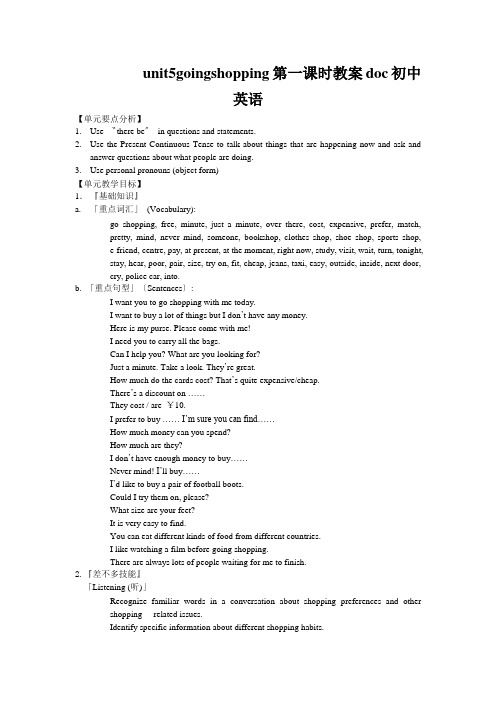
unit5goingshopping第一课时教案doc初中英语【单元要点分析】e 〝there be〞in questions and statements.e the Present Continuous Tense to talk about things that are happening now and ask andanswer questions about what people are doing.e personal pronouns (object form)【单元教学目标】1.『基础知识』a.「重点词汇」(Vocabulary):go shopping, free, minute, just a minute, over there, cost, expensive, prefer, match,pretty, mind, never mind, someone, bookshop, clothes shop, shoe shop, sports shop,e-friend, centre, pay, at present, at the moment, right now, study, visit, wait, turn, tonight, stay, hear, poor, pair, size, try on, fit, cheap, jeans, taxi, easy, outside, inside, next door,cry, police car, into.b. 「重点句型」〔Sentences〕:I want you to go shopping with me today.I want to buy a lot of things but I don’t have any money.Here is my purse. Please come with me!I need you to carry all the bags.Can I help you? What are you looking for?Just a minute. Take a look. They’re great.How much do the cards cost? That’s quite expensive/cheap.There’s a discount on ……They cost / are ¥10.I prefer to buy ……I’m sure you can find……How much money can you spend?How much are they?I don’t have enough money to buy……Never mind! I’ll buy……I’d like to buy a pair of football boots.Could I try them on, please?What size are your feet?It is very easy to find.You can eat different kinds of food from different countries.I like watching a film before going shopping.There are always lots of people waiting for me to finish.2.『差不多技能』「Listening (听)」Recognize familiar words in a conversation about shopping preferences and othershopping----related issues.Identify specific information about different shopping habits.「Speaking(讲)」Interact with others and talk about specifics. Use appropriate register.Conduct simple negotiations.Describe the layout of a shopping mall.「Reading(读)」Guess general meanings of new words by looking at pictures and keywords.Identify special information about shopping by reading the conversation.Respond to the text by doing a survey.「Writing(写)」Organize ideas, structure sentences and put them together in paragraphs.Describe and explain.【学习策略】Use vocabulary learning strategies for self-study.第一课时 The First Period【教学目标】1.『基础知识』a.「词汇」(Vocabulary):go shopping, free, bookshop, clothes shop, shoe shop, sports shop.b.「句型」(Sentences):I want you to go shopping with me today.I want to buy a lot of things but……I don’t have any money.Here’s my purse. Please come with me!I need you to carry all the bags.2.『差不多技能』a. To know some vocabularies about common presents.b. To learn new words related to this unit’s theme.c. To guess meaning from pictures and to sort vocabulary.d. To guess the meanings of words by recognizing shopping items and relating them totypical shops.【学习策略】使用词汇学习方法。
7AUnit5Goingshopping公开课教案
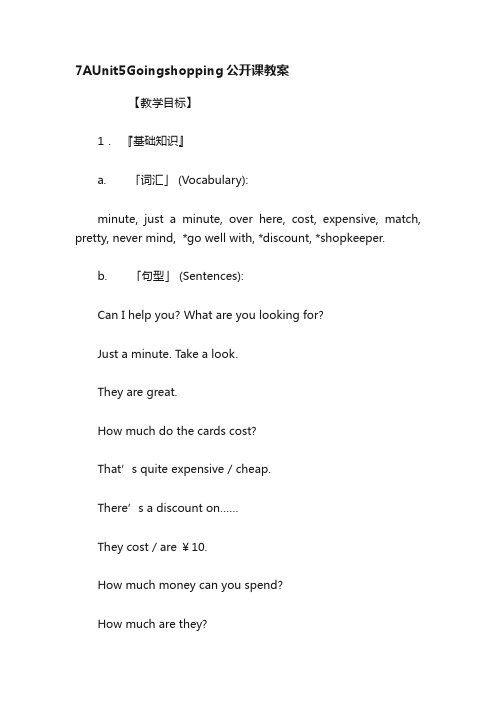
7AUnit5Goingshopping公开课教案【教学目标】1.『基础知识』a. 「词汇」 (Vocabulary):minute, just a minute, over here, cost, expensive, match, pretty, never mind, *go well with, *discount, *shopkeeper.b. 「句型」 (Sentences):Can I help you? What are you looking for?Just a minute. Take a look.They are great.How much do the cards cost?That’s quite expensive / cheap.There’s a discount on……They cost / are ¥10.How much money can you spend?How much are they?【教学过程】Step1:呈现1.通过简笔画创设情境,调动学生兴趣 T:Today I am very happy,because today is my birthday. I get some beautiful presents from my friends.Do you know what they are?2. 通过挂图,让学生自由回答。
They are…3.给学生创造一定情境,引导并帮助学生学习生词。
T:Yes.What is my favourite present?Can you guess? S:… T: Very good!I like the hair clips,they are very pretty.They match my clothes well. How much do they cost?They cost 4 yuan. They are not expensive enough. Because there is a discount on them.T oday,I bring them here.Do you want to have a look?Oh,just a minute,Where are they?Please help me find my hair clips. Never mind, take a look,they are over here.Thank goodness.4. 板书划线部分生词和短语,同时重复刚才的语境,让学生根据语境猜测词义。
unit5goingshopping第二课时教案doc初中英语
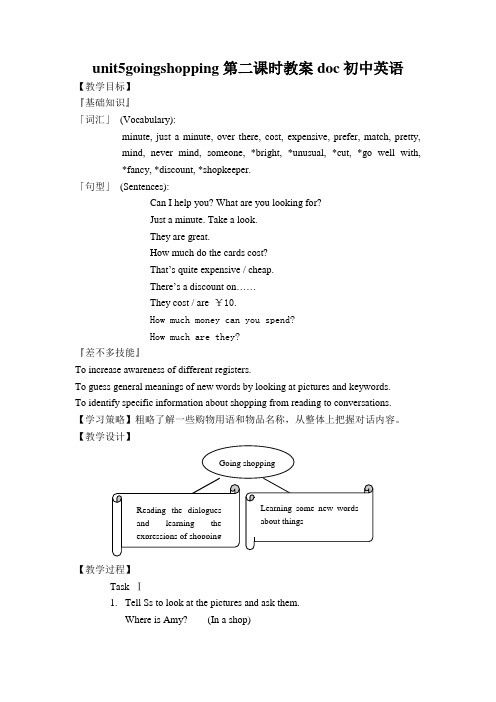
unit5goingshopping第二课时教案doc初中英语【教学目标】『基础知识』「词汇」(Vocabulary):minute, just a minute, over there, cost, expensive, prefer, match, pretty,mind, never mind, someone, *bright, *unusual, *cut, *go well with,*fancy, *discount, *shopkeeper.「句型」(Sentences):Can I help you? What are you looking for?Just a minute. Take a look.They are great.How much do the cards cost?That’s quite expensive / cheap.There’s a discount on……They cost / are¥10.How much money can you spend?How much are they?『差不多技能』To increase awareness of different registers.To guess general meanings of new words by looking at pictures and keywords.To identify specific information about shopping from reading to conversations.【学习策略】粗略了解一些购物用语和物品名称,从整体上把握对话内容。
【教学设计】【教学过程】Task Ⅰ1.Tell Ss to look at the pictures and ask them.Where is Amy? (In a shop)2.Ask Ss to skim the conversations on their own and underline any wordsthey do not know. Encourage them to guess the meanings of these wordsfrom the cont ext Get Ss to work out the meaning of ‘discount’ bydeduction as a class activity.3.Tell Ss to write down all the items Amy looked at and list their cost.Ask for volunteers to write the answers on the board.4.Play a 〝Price Bingo〞game to practice speaking and listening to theprices.Task Ⅱ1.Ask Ss to do Part B1 individually. Encourage Ss to guess the meanings ofwords from the context and the given definitions. Then check the answersas a class.2.Ask Ss to look at the table in Part B2. Explain that Amy did a survey ofthe most popular presents her friends would like to get hair clips as apresent? (Four) What is the most popular present for boys? (A computergame.)Tell Ss to discuss the results with their partners.【课堂检测】〔补全对话〕A: Can I 1 you?B: I want to buy a skirt 2 my daughter.A: What 3 do you want?B: Green or yellow.A: Look at the skirts over there. We have different colours. 4 one doyou like?B: I think the green one is nice. But it’s too big.A: What 5 this one?B: This one is OK. How 6 is it?A: 7 ¥28.50.B: All right. I’ll 8 it. 【教后反思】。
初一英语7A Unit5 Going shopping教案
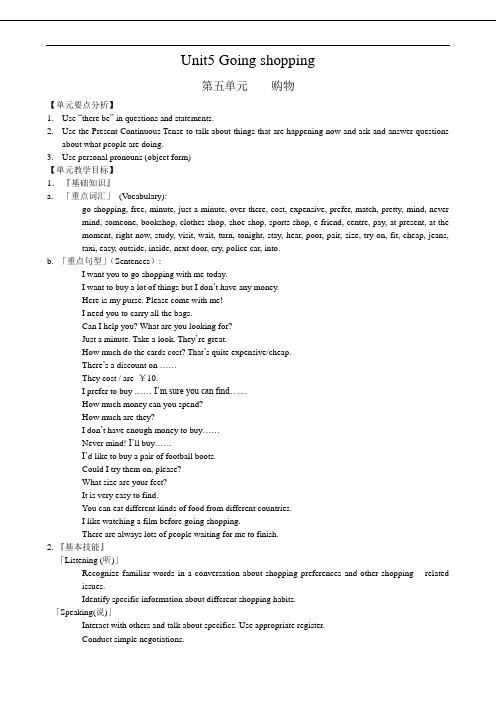
Unit5 Going shopping第五单元购物【单元要点分析】e “there be” in questions and statements.e the Present Continuous Tense to talk about things that are happening now and ask and answer questionsabout what people are doing.e personal pronouns (object form)【单元教学目标】1.『基础知识』a.「重点词汇」(Vocabulary):go shopping, free, minute, just a minute, over there, cost, expensive, prefer, match, pretty, mind, never mind, someone, bookshop, clothes shop, shoe shop, sports shop, e-friend, centre, pay, at present, at the moment, right now, study, visit, wait, turn, tonight, stay, hear, poor, pair, size, try on, fit, cheap, jeans, taxi, easy, outside, inside, next door, cry, police car, into.b. 「重点句型」(Sentences):I want you to go shopping with me today.I want to buy a lot of things but I don‟t have any money.Here is my purse. Please come with me!I need you to carry all the bags.Can I help you? What are you looking for?Just a minute. Take a look. They‟re great.How much do the cards cost? That‟s quite expensive/cheap.There‟s a discount on ……They cost / are ¥10.I prefer to buy ……I‟m sure you can find……How much money can you spend?How much are they?I don‟t have enough money to buy……Never mind! I‟ll buy……I‟d like to buy a pair of football boots.Could I try them on, please?What size are your feet?It is very easy to find.You can eat different kinds of food from different countries.I like watching a film before going shopping.There are always lots of people waiting for me to finish.2.『基本技能』「Listening (听)」Recognize familiar words in a conversation about shopping preferences and other shopping----related issues.Identify specific information about different shopping habits.「Speaking(说)」Interact with others and talk about specifics. Use appropriate register.Conduct simple negotiations.Describe the layout of a shopping mall.「Reading(读)」Guess general meanings of new words by looking at pictures and keywords.Identify special information about shopping by reading the conversation.Respond to the text by doing a survey.「Writing(写)」Organize ideas, structure sentences and put them together in paragraphs.Describe and explain.【学习策略】Use vocabulary learning strategies for self-study.第一课时The First Period【教学目标】1.『基础知识』a.「词汇」(Vocabulary):go shopping, free, bookshop, clothes shop, shoe shop, sports shop.b.「句型」(Sentences):I want you to go shopping with me today.I want to buy a lot of things but……I don‟t have any money.Here‟s my purse. Please come with me!I need you to carry all the bags.2.『基本技能』a. To know some vocabularies about common presents.b. To learn new words related to this unit‟s theme.c. To guess meaning from pictures and to sort vocabulary.d. To guess the meanings of words by recognizing shopping items and relating them to typical shops.【学习策略】使用词汇学习方法。
Unit5 Going Shopping教学设计
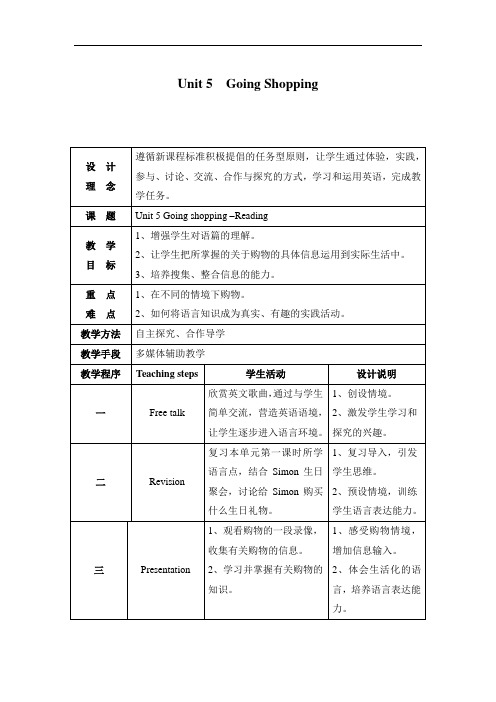
Unit 5 Going Shopping本课的教学内容是牛津初中英语教材7A的第五单元Going Shopping的第二课时Reading. 本课的教学目标:增强学生对语篇的理解。
通过教学情境帮助学生把握生词的含义和关键词猜测让学生把所掌握的关于购物的具体信息运用到实际生活中,培养学生的语言迁移能力,体现时代精神。
本课的教学重点是如何在不同的情境下进行购物,教学难点是如何将语言知识成为真实、有趣的实践活动,“学中用,用中学”养成良好的生活习惯和生活能力,为终身学习打下基础,真正体现素质教育的思想。
在处理这节课时,主要遵循了新课程标准积极提倡的任务型教学原则,让学生通过体验、实践、参与、讨论、交流、合作与探究的方式,学习和运用英语,完成教学任务,在课堂教学中主要采取了以下几点的教学方法:1、设计了旨在培养学生听、说、读、写四方面的教学环节。
2、采取了形式多样的活动,激发学生的学习热情。
3、创设语言情境,让学生在模拟购物环节中培养学生运用语言的能力。
同时,想通过这节课的教学,试图解决让学生在不同的情境下如何购物的问题。
同时,在本节课又设计了如何支配零花钱的问题,从而对学生进行了正确的引导和思想渗透。
教会他们学会学习,学会生存,认识社会,学会生活。
教学流程:(一)Free talk: 通过与学生的简单交流,让学生逐步进入语境,营造英语语言环境。
(二)Revision: 通过设计Simon过生日,如何购买生日礼物环节,活跃学生的思维,同时又复习了第一课时所授内容,从而自然地导入购物的话题。
(三)Video通过一段录像,为学生创设了一个现实购物情境,让学生对现实生活有一种体验。
(四)Video通过复播录像,同时加入文字说明,让学生更直观地感受了如何购物,让课堂和现实生活紧密地结合在一起。
(五)V ocabulary通过录像中的shopkeeper,设计了生词教学,在这个环节注意把生词进行了整合,让学生在一个整体结构中去认知生词,运用生词,同时为学生输送了一些关于购物的有用信息。
- 1、下载文档前请自行甄别文档内容的完整性,平台不提供额外的编辑、内容补充、找答案等附加服务。
- 2、"仅部分预览"的文档,不可在线预览部分如存在完整性等问题,可反馈申请退款(可完整预览的文档不适用该条件!)。
- 3、如文档侵犯您的权益,请联系客服反馈,我们会尽快为您处理(人工客服工作时间:9:00-18:30)。
教师学科教案[ 20 – 20 学年度第__学期]任教学科:_____________任教年级:_____________任教老师:_____________xx市实验学校Unit5 Going shopping 教案单词wallet idea way already shopkeeper minute/just a minutecost quite/very expensive/cheap discount fancy prefer match pretty also enough high/short bookshop invite turn pay stay collect country codonatepair boot size jeans skirt grey take note centre taxi rankoutside/inside before/after词组at the moment Never mind be free carry bags pencil box/caseprefer to go shopping hair clip photo album comic bookstry on yours sincerely raise money for课堂参与1 回答unit 5相关问题1.1 P74. What does Hobo want Eddie to do?1.2 What doesn’t Hobo have?1.3What does Eddie give Hobo?2. 问相关礼物的英语表达2.1 CD pencile box hair clips stickers music box yo-yo photo album comic books2.2 关于节日送礼物方面的对话What do you buy for your best friend’s birthday?What do you want on your birthday?What do you buy for your parent s’ birthday?Where do you buy this book?3.要点提示3.1 come up 即将来临Mike’s birthday is coming (up).Come in 进来(come on in更亲近) come back 回来I’ll come back in two hours.3.2 buy sth. for sb.=buy sb. sth. 给某人买东西I’ll buy you a pencil box on your birthday.=I’ll buy a pencil box for you on your birthday.3.3 be free 空闲的。
Amy is free this afternon. We can paly basketball together.Are you free tomorrow? I would like to invite you to my house for lunch.免费的. The second skirt is free if you buy one.4 cost pay take spend的用法4.1 Cost的主语必须是物或事,表示“花费”。
It costs me RMB10 to buy a burger in KFC.4.2 Pay 和pay for都表示“付钱”,用法不同。
Pay用作及物动词,后接表示人的词语。
即pay sb.意为“付款给某人”I pay him RMB5 to buy a bottle of coke.Have you paid the cashier?Pay for 中的pay为不及物动词,其宾语多为物。
即pay for sth.意为“付款买某物”。
I cannot pay for this TV at the moment.如其宾语为人,即pay for sb.意为“为某人付款”Shall I pay for you for this wallet?另外表示给“某人钱买某物”pay sb money for sth.I paid the shopkeeper for two bags of rice.4.3 spend的主语必须是人,常用于以下结构:(1) spend time /money on sth. 在……上花费时间(金钱)。
例:I spent two hours on this maths problem.(2) spend time /money (in) doing sth. 花费时间(金钱)做某事。
They spent two years building this shopping mall.(3)spend money for sth. 花钱买……I spend money for CDs.4.4 take后通常用双宾语(1) It takes sb. +时间+to do sth. 做某事花了某人多少时间。
It took me two hours to finish this work.(2)doing sth. takes sb.Repairing this old frige took me the whole day.5. show ab. around sth. 带某人参观某地。
I’ll show you around our palyground.6. What is your size?—I am a size 6.随堂检测A.Can I ( help ) you?B.Yes, I want to buy a T-shirt ( for ) my dad.A.What ( colour ) do you want?B.Grey or black.A.Look at the T-shirts over there. We have so many colours, ( what) do you like?B.I think the grey one is nice.But it’s too small,A.What ( about ) this one?B.This one is fine. How ( much ) is it?A.It’s RMB158.B.All right. I’ll ( take ) it.语法讲解一般现在时和现在进行时的用法1一般现在时表示现阶段经常或习惯发生的动作或存在的状态,或说明主语的特征。
1.1 一般现在时句子中常有的时间状语:often,usually,sometimes,always,every (day等), once/twice,a (week等), on (Sunday等),never,in the (morning等)。
Lucy goes to the school library twice a week.1.2表示客观真理、事实、人的技能或现在的状态时句子里一般不用时间状语。
The earth turns round the sun.1.3表示十分确定会发生(如安排好的事情)或按照时间表进行的事情,用一般现在可以表达将来,句子中可以有将来时间。
The bus for school leaves at 7am in the morning.1.4 在时间状语从句中(以when, after, before, while, until, as soon as等引导)和条件状语从句中(以if,unless引导),用一般现在时代替一般将来时,句子可以有将来时间。
Please ring me as soon as you arrive in Beijing.If it rains tomorrow,we will have to stay at home.1.5一般现在时用于倒装句中可以表示正在发生的动作,动词以come, go为主。
Here comes the bus. There goes the bell.1.6 一般现在时常用于体育比赛的解说或寓言故事中。
Now the midfield player catches the ball and he keeps it.1.7 人的心理活动和感官动作一般用一般现在时而不用现在进行时表达,常见动词有:like, love, hate, dislike, want, wish, hope, think(认为),understand, remember, forget, mean, need, hear, feel, see.I really hope you can enjoy your stay here.Lily loves reading comic books very much.2现在进行时现在进行时表示现在正在进行的动作或是现阶段正发生而此刻不一定在进行的动作。
2.1 现在进行时由“助动词be (am is are ) +现在分词”构成。
2.2现在进行时的时间状语有:now, this …, these…等,但经常不用。
Maggies is writing a new novel these days.I am going shopping this afternoon.2.3 表示即将发生的动作,一般指近期安排好的事情。
常见的动词有:come, go, stay, leave, spend, do等。
I am coming now. Sanding is leaving soon.2.4 表示频繁发生或反复进行的动作,常与always等频度副词连用,以表示赞扬、不满或讨厌等感情色彩。
Lucy is always coming to school early and cleaning the classroom.●以辅音+ y结尾的动词,现在分词形式应在y后直接加-ing,字母y不变化。
例:cry – crying, hurry – hurrying课堂讨论How to help poor children in poor areas?。
